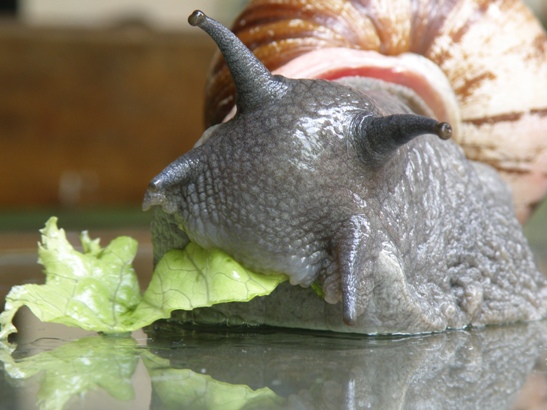
Nutrition
Daedalochila postelliana is a heterotrophic gastropod who dines upon entrees like fungi for nutrients (Pilsbry, 1940). This species also occasionally devours decayed vegetation, plants, and bark (Dourson, 2010). Daedalochila postelliana crawls along the forest floor of most southeastern states of North America (Pilsbry, 1940). It is in this territory where the snail enjoys snacking on whatever ends up on the menu. It can take Daedalochila postelliana from five minutes to one hour to digest food. The length of this ‘lunch hour’ is dependent upon the substance of the food. (Dourson, 2010).
Like most gastropods, Daedalochila postelliana locates food using chemoreceptors that are located on its two lower tentacles (Dourson, 2010). These instruments patrol the air and ground for any signal of nearby food. When a food source is located Daedalochila postelliana rasps away layers at a time using a structure called a radula (Hickman et al. 2009). This teeth-like tongue leads to the digestive tract where the food is then passed through a digestive gland, intestine, stomach, and kidney (Hickman et al. 2009). Waste is ejected out of an opening positioned above the head (Hickman et al. 2009). This unusual adaption is caused by torsion. A process that occurs during early developmental stages (Hickman et al. 2009).
Daedalochila postelliana has also developed a very prominent basal tooth (Dourson, 2010). The basal tooth is completely composed of calcium carbonate, which is the same material its shell is made up of (Dourson, 2010). The tooth is utilized as a place to store calcium carbonate and can be used to build up the shell (Dourson, 2010). To build shells and teeth Daedalochila postelliana also needs to consume limestone or some source of calcium carbonate (Dourson, 2010). The consumption of these calcium carbonate sources is critical, because without these substances there wouldn’t be any material to build their teeth and shells. A circumstance that would be detrimental to their survival and will leave them vulnerable to attacks from predators.
Reproduction is next!
Or return to the Home page.
